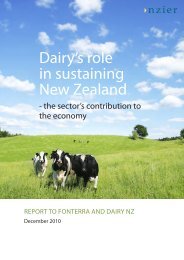You also want an ePaper? Increase the reach of your titles
YUMPU automatically turns print PDFs into web optimized ePapers that Google loves.
Brian and Jacqui Wellington<br />
BEEF + LAMB NEW ZEALAND LIVESTOCK FARM AWARD<br />
MASSEY UNIVERSITY DISCOVERY AWARD<br />
Brian wears his passion for deer farming well,<br />
and the award judges found it serving him well<br />
too on his 620ha (600ha effective) family farm<br />
southeast of Te Awamutu.<br />
Brian and Jacqui are, according<br />
to the judges, “enthusiastic<br />
farmers with a clear long-term<br />
vision”. The couple added deer<br />
to the drystock mix at their<br />
Wharepapa South property in<br />
1978 and their commitment to<br />
the deer industry has remained<br />
steadfast since. “When people<br />
were getting out of deer we<br />
did the reverse, we increased<br />
our numbers,” recalls Brian.<br />
Since taking charge and purchasing the Wellington family<br />
property 28 years ago, Brian and Jacqui have bought three<br />
adjacent blocks of land. The original Wellington farm was a<br />
sheep and beef property, Brian the third generation of his family<br />
to farm it. But on Brian and Jacqui’s watch the business has<br />
grown in size and evolved into the attractive, well developed<br />
deer, sheep and dairy grazing unit it is today, a home base for<br />
their children – Andrew, Susan, Christine and Robert – who<br />
range in age from 23 to 18.<br />
The judges commended the development Brian and Jacqui<br />
have undertaken noting, “high standard internal access race, a<br />
lot of thought gone into infrastructure, and excellent fencing<br />
of waterways and planting of natives”. Brian lists facial eczema<br />
as their “single biggest challenge”. “The climate is pretty good<br />
JUDGES’ COMMENTS<br />
here,” he says. “It’s not summer dry and doesn’t get too wet<br />
in the winter either.” Last year 500 ewes, 250 lambs and 500<br />
dairy grazers were wintered on the farm, but it is deer that is the<br />
main focus, as the numbers illustrate: 1500 red deer hinds, 700<br />
velveting stags and 1250 red and wapiti-cross fawns.<br />
Contour is rolling with steep faces. Some of the steeper areas<br />
were planted in pines but their intended use has altered. “They<br />
were going to be woodlots for our retirement,” explains Brian,<br />
“but instead we have found they have massive value for the<br />
hinds. Those tree areas allow us to have 1000 hinds off the<br />
pasture through the winter. The hinds love it in there and it<br />
takes the pressure off everywhere else on the farm too.”<br />
The management of the hinds in the pines is where Brian’s<br />
observational skills and keen interest in deer behaviours are put<br />
to excellent use. Every third day barriers on the self-feeding<br />
silage pits are moved forward. Any hinds not able to get enough<br />
food, or being picked on by more dominant hinds are spotted<br />
and separated out during their monthly visit through the yards.<br />
They are then run in a separate herd and, says Brian, “pick up<br />
again really well”. There were just 30 (three percent) in this herd<br />
when the hinds were brought out of the pines in September<br />
last year.<br />
The pines, high pruned up to eight metres, are an ideal<br />
environment for the hinds, whatever the season. In addition to<br />
winter, close to fawning they have open gate access from their<br />
pasture to the tree cover. Brian has noted the behaviour of the<br />
hinds is not dictated by space. In winter half are in a 10ha block<br />
of trees and the other in two hectares. “But the smaller block<br />
never has more picked on than the larger one.”<br />
Silage in the pits is fine cut, so there is some wastage by the<br />
deer. However, the Wellingtons have devised a way to ensure<br />
•<br />
Impressive innovation around deer farming practise; observation of behaviour, experimentation with fencing.<br />
•<br />
Well managed feed demand and surpluses for year round supply.<br />
•<br />
Very tidy well-presented farm with a lot of thought gone into infrastructure.<br />
Always open to the sharing of new ideas and innovations.
















